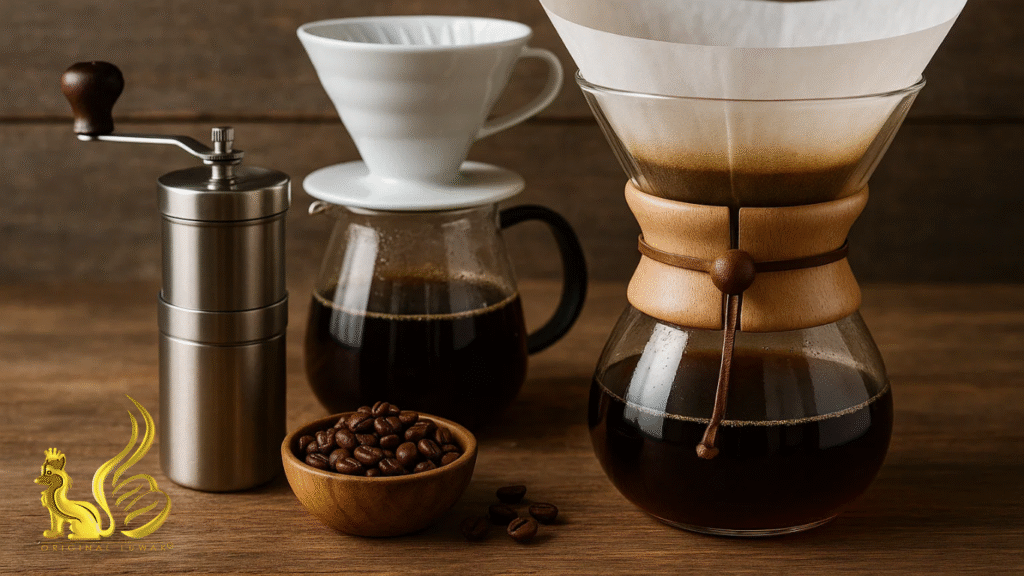“It wasn’t just coffee. It was a ritual.”
Have you ever wondered how the pour-over method for Kopi Luwak transforms a rare coffee into something unforgettable? On a quiet morning, as steam curls from your cup, the careful rhythm of a V60 or Chemex pour brings out the true character of this luxury brew. From the smooth body to the chocolatey notes, each sip tells the story of wild civets, natural fermentation, and meticulous craft. Whether you’re a beginner or a seasoned coffee aficionado, this guide will show you how to make every drop of Kopi Luwak count.
Let’s turn your coffee moment into a mindful masterpiece.
How the Pour-Over Method for Kopi Luwak Brings Out Its Best
You’ve spent good money on authentic Kopi Luwak. Don’t let that go to waste with a generic brewing method. The pour-over method for Kopi Luwak — using tools like the V60 or Chemex — is the gold standard for showcasing subtle, refined flavors.
Here’s why it works beautifully with civet coffee:
- Silky Smoothness: The coffee’s body feels creamy and round, not harsh.
- Low Acidity: Fermentation in the civet’s stomach reduces sharpness naturally.
- Rich Aroma: Pour-over amplifies chocolatey, nutty, and earthy notes.
- Clarity: Paper filters clean out bitterness and oils for a crisp finish.
💡 Still unsure what makes Kopi Luwak special? Learn more in our complete guide.
What Makes Kopi Luwak’s Flavor So Unique?
Here’s where things get fascinating — it’s not just a luxury, it’s a biological miracle.
- Selection Process: Civets only eat the ripest coffee cherries.
- Fermentation: Digestive enzymes in the civet’s gut break down proteins, softening the bean’s flavor.
- Maillard Reaction: During roasting, these pre-fermented beans develop rich caramel and cocoa notes.
👉 Curious about the science? We’ve got you covered in this digestive enzyme deep dive.
As a result, Kopi Luwak offers:
- A smooth, low-acid taste
- Hints of chocolate, hazelnut, and earthy tones
- A luxurious mouthfeel that no other coffee can replicate
According to the Specialty Coffee Association, brewing methods like pour-over can dramatically enhance coffee’s complexity — which is why they’re often used in competitions and cupping evaluations.
V60 or Chemex: Which Pour-Over Method Suits Kopi Luwak Most?
Both pour-over methods work great, but each has a unique personality.
☕ Chemex
- Filter: Extra thick
- Result: Extremely clean, delicate, and sweet
- Best for: Highlighting clarity and floral/caramel notes
☕ V60
- Filter: Thinner, ribbed
- Result: Brighter, more vibrant, slightly more body
- Best for: Complex flavors and faster brewing
Want to get technical with your brew? Check out our Kopi Luwak brewing guide.
Step-by-Step Pour-Over Brewing Instructions for Kopi Luwak

Let’s make this easy. Whether you’re using a V60 or Chemex, here’s what to do:
- Grind Your Beans
Medium grind (like sea salt). Freshly ground Kopi Luwak beans are essential. - Rinse the Filter
Pour hot water through the filter to remove any papery taste. - Bloom (Critical!)
Pour just enough hot water to wet the grounds (twice the weight of the coffee). Wait 30–45 seconds. - Slow Pour
Pour water in a slow spiral, avoiding the edges.- V60: 2.5–3.5 mins
- Chemex: 4–5 mins
- Savor It
Inhale the aroma, sip slowly, and let the velvety smoothness dance on your palate.
Don’t Ruin Your Kopi Luwak — Avoid These Mistakes
- ❌ Using stale beans – Always buy fresh, authentic Kopi Luwak.
- ❌ Over-extracting – Too long = bitterness. Time it.
- ❌ Bad water – Use filtered water around 92–96°C.
- ❌ Fake beans – 80% of what’s sold as “Luwak” isn’t legit. Learn how to spot fakes.
Why Choose Originalluwak.com for Your Kopi Luwak?
You deserve more than just rare coffee — you deserve authenticity, transparency, and ethical sourcing. That’s why thousands of coffee lovers trust Originalluwak.com as their go-to source for genuine, wild-sourced Kopi Luwak.
What sets us apart?
- ✅ Wild-Sourced Only – No caged civets. Ever. Learn more about wild vs caged civet coffee.
- ✅ Laboratory-Tested Authenticity – See our cupping test process.
- ✅ Transparent Origin – From our plantation to your cup.
- ✅ Halal & Hygienic – Certified safe and halal.
☕ Ready to experience real luxury in every sip?
Visit our product page and order your authentic Kopi Luwak — shipped globally with care.
Brewing with Purpose
The pour-over method for Kopi Luwak is more than a brewing choice — it’s respect. Respect for the civet’s natural selection, the slow fermentation, the smooth profile, and your own daily ritual.
Ready to elevate your ritual?
Explore our store or learn about pricing before you invest.
What’s stopping you from turning your next cup into a story worth sipping?




















